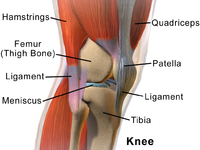
Photo from wikipedia
ABSTRACT Altering torsional stiffness of cycling shoe soles may be a novel approach to reducing knee joint moments and overuse injuries during cycling. We set out to determine if the… Click to show full abstract
ABSTRACT Altering torsional stiffness of cycling shoe soles may be a novel approach to reducing knee joint moments and overuse injuries during cycling. We set out to determine if the magnitude of three-dimensional knee moments were different between cycling shoe soles with different torsional stiffnesses. Eight trained male cyclists cycled at 90% lactate threshold power output in one of two cycling shoe conditions in a randomized crossover design. The shoe sole was considered torsionally flexible (FLEX) compared to a relatively stiffer (STIFF) sole. Gross efficiency (GE) and knee joint moments were quantified. No significant effect of shoe condition was seen in GE (21.4 ± 1.1% and 20.9 ± 1.6% for FLEX and STIFF, respectively, P = 0.12), nor in three-dimensional knee moments. 4 of the 8 subjects had reduced knee moments in at least 2 of the 3 moment directions. These “responders” were significantly shorter (1.73 ± 0.02 m vs 1.81 ± 0.04 m, P = 0.017) and had a higher relative maximal aerobic power (MAP) (4.6 ± 0.3 W∙kg-1 vs 3.9 ± 0.3 W∙kg-1, P = 0.024) compared to non-responders. These results suggest that certain shoe characteristics may influence certain individuals differently because these participants belong to different “functional groups”; certain individuals may respond positively to FLEX, while others may not. Further studies should test this proposed hypothesis.
Journal Title: Journal of Sports Sciences
Year Published: 2019
Link to full text (if available)
Share on Social Media: Sign Up to like & get
recommendations!